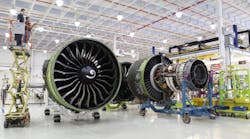Due to its record production on a new-generation of jet engines, engine components and aircraft systems, GE Aviation announced on February 15 that its investments reached $4.3 billion in its expanding U.S. operations during 2011-2016. (Another $1.1 billion invested in its international sites.)
The U.S. investments include $214 million to establish five new plants in Ellisville, Miss. Auburn, Ala.; Asheville, N.C.; Lafayette, Ind. and Huntsville, Ala. About two million square feet of new manufacturing floor space is being created.
“GE Aviation is a global company with significant technology capability around the world,” said Colleen Athans, GM of the GE Aviation Supply Chain. “At the same time, we are introducing several highly proprietary technologies that are upping our manufacturing capabilities in the United States."
GE Aviation has upgraded current U.S. operations, including expansions in West Jefferson, NC; and Hooksett, New Hampshire; and created centers for emerging technologies such as additive manufacturing, digital engine monitoring, ceramic matrix composites (CMCs) and electrical distribution.
The company said it will create the country’s first fully-integrated supply chain company to mass produce components from its heat-resistant, lightweight CMC components. These components go into the hot section of commercial jet engines. The materials will move from a CMC raw materials plant in Huntsville to CMC manufacturing research labs in Cincinnati, Ohio; and Newark, Delaware; to full-scale CMC production in Asheville.
The company has also created an Additive Development Center in northern Cincinnati and a component production operation in Auburn where more than 40 additive machines are mass producing commercial and military engine components.
GE Aviation has about 44,600 employees worldwide at 85 sites (47 in U.S.), including more than 25,000 U.S. employees (16,500 in the U.S. supply chain). GE Aviation has an industrial backlog of more than $150 billion. GE Aviation and CFM International, a 50/50 joint company of GE and Safran Aircraft Engines, collectively have a backlog of more than 15,000 jet engines.
About two-thirds of GE Aviation’s more than $25 billion in annual revenues are generated from international sales – this includes about 75% of GE Aviation’s commercial revenues derived internationally. In general, about half of a GE commercial jet engine is produced with U.S. content.




